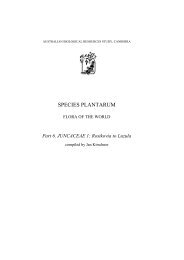Part 7. JUNCACEAE 2: Juncus - Species Plantarum Programme
Part 7. JUNCACEAE 2: Juncus - Species Plantarum Programme
Part 7. JUNCACEAE 2: Juncus - Species Plantarum Programme
You also want an ePaper? Increase the reach of your titles
YUMPU automatically turns print PDFs into web optimized ePapers that Google loves.
30<br />
SPECIES PLANTARUM — FLORA OF THE WORLD (2002)<br />
Perennials, 30–40 (–50) cm tall, loosely caespitose, robust; rhizome creeping, branched, with<br />
internodes 1–3 cm long, c. 3 mm in diam.; sterile shoots/stolons short. Stem erect or<br />
ascending, compressed. Cataphylls c. 1–3, to 5–8 cm long, with base brownish-purplish.<br />
Cauline leaves 3–6, dense, usually to 10–13 cm long, flat to V-shaped, (2.5–) 4.0–6.0 (–8.0) mm<br />
wide; margins smooth; apex acute. Lower bract leaf-like, c. 1–3 cm long, shorter than<br />
inflorescence. Inflorescence decompound, sometimes supra-decompound, much branched,<br />
anthelate; branches erecto-patent, diffuse, of numerous 2–6-flowered echinate heads c. 3–5 mm<br />
wide. Capitulum bracts ovate-acuminate, aristate, to 2 mm long, ±scarious. Tepals ±unequal,<br />
linear-lanceolate, acuminate, subaristate, greenish, sometimes suffused reddish, smooth;<br />
outer tepals shorter, 2.4–2.8 mm long; inner tepals c. 2.7–3.5 mm long, margins narrow, paler<br />
green or purplish. Stamens 6, rarely 3–5; anthers c. 0.8–0.9 mm long; filaments c. 0.3 mm long,<br />
flat; style not easy to distinguish from distal part of capsule, to c. 0.5 mm long; stigmas<br />
c. 1.0 mm long. Capsule trigonous, unilocular, narrowly prismatic-pyramidal, elongated, to<br />
c. 4.5–5.5 mm long, much exceeding perianth, very gradually narrowing into style, pale<br />
brown. Seeds 0.6–0.7 mm long, pale brown, faintly reticulate; appendages absent.<br />
Restricted to C and S Turkey. 34: TUR. Wet places, mostly along, or even in streams. Map 18<strong>7.</strong><br />
34. TURKEY: Gediz, Murat Dagh, 1400 m, P.H.Davis 36712 (E); Içel, Giosna [Gözne], 800 m, W.Siehe 196<br />
(W); Afyon, Sultan Dagh, 1500 m, J.F.N.Bornmüller [It. Anatol. 3] 5614 (W); Adana, 18 km N of Kamisli,<br />
1400 m, Sorger 7729-7 (W); 7 km W of Fetiye, 5 Jun 1977, H.Woldrinf E12 (L).<br />
11. <strong>Juncus</strong> engleri Buchenau, in H.G.A.Engler, Pflanzenr. (iv.36) 25: 248 (1906)<br />
T: Ostafrikanisches Waldgebiet, West-Usambara, 1400–1600 m [Tanzania, W Usambara Mtns], A.Engler<br />
1060; syn: B, destroyed; A.Engler 1409; syn: B, destroyed.<br />
Perennials, 25–40 (–60) cm tall, loosely caespitose; rhizome creeping-ascending; stolons<br />
absent; stems ascending, rooting, with internodes short; cataphylls absent. Leaves only basal,<br />
mid-green, 12–20 (–40) cm long, (3–) 5–8 (–12) mm wide near base, ±flat to channelled;<br />
sheaths closed, to 2 cm long, later split, usually tinged reddish, with margins colourless or<br />
whitish, c. 0.1 mm wide; auricles absent; leaf apex subulate. Stems terete, ±smooth, leafless.<br />
Lower bract subherbaceous, c. 1.0–4.0 cm long, shorter than inflorescence. Inflorescence<br />
±erect, anthelate; main branches usually 5–10, (1–) 2–6 (–8) cm long, ±smooth; secondary<br />
branches subdistal; upper bracts blackish-brown, scabrid (papillose), subtending<br />
hemispherical (1–) 3–7 (–10)-flowered heads; uppermost bracts c. one per flower, c. 3 mm<br />
long, ±triangular, brownish. Tepals ±unequal; outer tepals lanceolate, carinate, acuminate,<br />
c. 2.4–2.7 mm long, dark brown, often scabrid on midrib, with margins narrow and<br />
indistinct; inner tepals ovate-lanceolate, broader, c. 2.5–2.8 × c. 1.0 mm, obtuse, dark brown,<br />
with margins broad, membranous. Stamens 6; anthers 0.5–0.8 mm long; filaments 0.6–0.7 mm<br />
long; style c. 0.2 mm long; stigmas ±reddish, patent-contorted, c. 0.6–0.9 mm long, long<br />
papillose. Capsule oblong-ovoid, subtrigonous, ±abruptly contracted in an apiculate apex,<br />
c. 1.9–2.5 mm long, shorter than to subequalling perianth, shiny, red-brown above. Seeds<br />
±ovoid, paler brown, 0.4–0.5 mm long including a short whitish apex, c. 0.3 mm wide,<br />
faintly reticulate to almost smooth; appendages ±absent.<br />
Confined to a very limited area in the Usambara Mtns and the Pare Mtns, Tanzania.<br />
25: TAN. Boggy places, along streams in open mountain forest. Map 188.<br />
25. TANZANIA: Lushoto, Magamba, Mkuzi R., c. 1750 m, P.J.Greenway 9664 (S); Lushoto, between Mkuzi<br />
and Kifungilo, R.B.Drummond & Hemsley 2214 (K); Pare, Mtonto, P.J.Greenway 6548 (K).<br />
Closely related to J. lomatophyllus of southern Africa but having very short style and<br />
stigmas, smaller flowers and, on average, substantially narrower leaves. The third original<br />
specimen cited, Usambara, Mlato [Mlalo] Holst 334a (W), is a <strong>Juncus</strong> inflorescence. It may<br />
belong to J. engleri but tepals are longer than those in the rest of the material. Buchenau<br />
himself listed the specimen with a question mark. Another unnumbered gathering from the<br />
same locality [Holst s.n. (PR)] represents <strong>Juncus</strong> oxycarpus.












